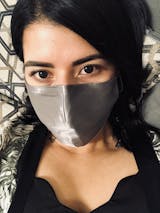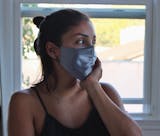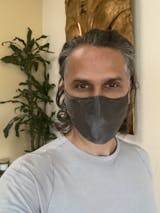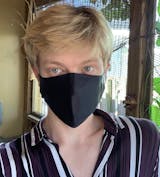You might be surprised at the amount of water that goes into making a single beauty product. Water is required at every stage of the production process – sourcing ingredients, extracting them, producing the container and packaging, and in cleaning and other regular processes.
Water is a free gift given to us by nature and we’re welcome to help ourselves to it, but the problem with using it in industrial processes is that the waste water is often heavily polluted and contaminated, and detrimental to the environment.
So, let’s talk about water waste in the beauty industry, its effect on our environment, and shine a spotlight on some brands that are trying to reduce their water consumption. Fait avec Coeur is a brand that emphasizes and encourages sustainable beauty, and our products reflect our values.
How is Water Waste Created?
Wastewater is defined as “water that has been used in the home, in a business, or as part of an industrial process”. So it’s created when businesses or companies – or even you, the individual – do literally anything with water.
Is there a difference between water waste and wastewater? Yes. The former might refer to actually wasting water, which you could argue isn’t being done when it’s being used for a definite purpose. However, the point we’re trying to make is that certain products, brands and processes create more wastewater than others do, so they are, comparatively speaking, wasting water.
Many brands use water as needless filler in liquefied products such as soaps, lotions and creams. Many others use ingredients that require large amounts of water to produce. Did you know, for instance, that it takes 1.1 gallons of water to grow a single almond? And almonds aren’t even at the top of the list when it comes to the most water-intensive crops.
Many brands that use harsh chemicals create wastewater that’s loaded with pollutants that can wreak havoc on the environment if released untreated.
Now, let’s circle back to what we said earlier – which was that wastewater is created in every industry, business and home. We simply cannot eliminate it. However, what we can do is limit the amount of wastewater that’s being created by switching to better ingredients and practices, avoiding unnecessarily liquefying products, and by generally being more mindful.
What is the Environmental Impact of Wastewater?
While the Earth is covered in water, with more water threatening to come rushing in thanks to global warming, only 1% of all this water is available to us in the form of clean, drinking water. The strain of our demand may lead to a major water crisis. According to the World Wildlife Fund, as much as two-thirds of the world’s population may face a water shortage by 2025.
So, while water is an endlessly renewable resource, clean drinking water isn’t – and that’s just the beginning of our problems.
Wastewater leads to water contamination, because it contains oils, solvents, detergents, pesticides and various other chemicals that are unfit for consumption.
It also leads to spread of disease, soil degradation, corrosion, pollution, disruption of ecosystems (when it’s released into a water body, for instance), and many other problems. The chemicals in wastewater can reach our drinking water supplies and turn it hazardous, taking away from the small amount of fresh drinking water we do have available.
There are many states in America now facing a water crisis. Oregon tops the list, with over 67% (or two-thirds) of the state in extreme drought conditions. Other states that are on the list include Washington, California, Nevada, Idaho and Montana. Numerous African and Asian countries are facing water scarcity as well.
Now, while drought isn’t caused due to waste water, it is tangentially related because if less water were used (and less waste water created), more clean drinking water would be available, and a lot fewer people would be facing a water shortage.
How Can We, As a Community, Help?
We started this article with a mention of sustainable beauty, and this is how it ties in to the water shortage problem. There are many ways in which we can help reduce the water crisis – and investing in brands that are doing good work is one of them. Let’s look at some tips.
Reuse water where possible
This is an excellent way to reduce your water use. Water used for washing vegetables, for instance, can be reused to wash dishes or to water your plants. If you use eco-friendly soap, you can also repurpose the water used in baths to water your garden. It will involve some setup initially, but your water bill will go down, and you’ll feel better about it.
Avoid wasting water
Shut the faucet while brushing your teeth, fix leaky taps and pipes, take shorter showers, and put a bottle in the flush compartment, so each flush uses a smaller amount of water. Be mindful of your water use while cleaning, and avoid using water where it isn’t actually necessary. Grass lawns need a lot of watering, so try planting your lawn thick with shrubs and ground cover instead. Also – people have been showering less often during the pandemic, so if you choose not to shower daily, we’ll keep your secret!
Harvest rainwater
This wonderful gift of nature is mostly wasted in urban settings, and it flows into the sewer and mixes in with wastewater. A rainwater harvesting system is surprisingly simple – all you need is a large bucket or container and some good guttering on your roof. You can use this water for cleaning, bathing your animals, to water the garden, or anything else you feel comfortable with.
Buy products from eco-friendly companies
There are brands that care about the customer, and there are brands that care about the environment and the customer. Choose the latter category, because demand and supply is a huge driving force that dictates global trends. Invest in brands that sell sustainable beauty products. Most companies that do so are more than happy to announce the fact, which makes finding them a breeze. However, to get you started, we’ve made a list of some of our favorites below.
Dry shampoo is a huge thing, and there are many other products that have no water in them. Opt for water-free products to reduce your water consumption. You might think it’s a tiny amount – after all, we only use a couple drops of each product at a time – but if millions of people pick up on the trend, then drastically smaller quantities of water will be needed in the production process. So, switch to products that come in bars or in gel form.
5 Brands That Are Getting it Right
With environmental issues getting more and more serious, companies round the world are springing into action. Many brands are informing themselves about the water crisis, and thinking of innovative ways in which they can help. Here are five brands that we think are doing exceptional work in this area:
Weleda
This Switzerland-based company reduced its water consumption by a whopping 25% in 2013. This is a brand that’s ahead of the game, with about 50% of its direct energy coming from renewable sources. They also prioritizes raw ingredients that come from organic or biodynamic farming. They use biodegradable packaging peanuts, partner with TerraCycle for recycling, and generally do a lot of good things for our environment.
LOLI Beauty
Tina Hedges, the founder of LOLI, strongly believes that powerful ingredients should not be diluted – which is exactly what happens when you liquefy them by adding water. The products sold by LOLI are all water-free, trash-free, toxin-free, waste-free, and slavery-free. All their ingredients are food grade and responsibly sourced, and the brand donates to charities that help stop human trafficking.
Body Stones
These Body Stones are a range of solid body moisturizers. These work just as well as traditional moisturizer, while placing much less stress on our water reserves. While most moisturizers are made with over 80% water and filler, these are made with 80% pure cocoa butter. So the product is more concentrated, long-lasting, and eco-friendly.
Uzza
Uzza Skincare produces moisturizers, cleansers, creams and more while staying water-responsible. Their cleanser and scrub, for example, are made with hydrolats as a water substitute. In addition, they use recycled washing water to reduce their consumption of this precious natural resource. They use ocean waste plastic in their packaging, and their ingredients mostly come from Moroccan women’s cooperatives.
Aloe Attiva
This brand does away with chemical thickeners and preservatives, and uses an aloe-activated elixir as a water substitute. Not only does this do a better job at giving you youthful, de-stressed skin, but it uses a significantly reduced amount of water. Instead of diluting down their products, they choose to provide a powerful package that’s full of goodness.
Many more brands are jumping onto the sustainable beauty bandwagon – and that’s great news! So the next time you run out of shampoo, cleanser, lotion or serum, instead of going with the product you usually use, take five minutes to check out a waterless product instead, and give it a try!
The Bloom Jelly Serum Bar by DewMighty
Fait avec Coeur is an environmentally-friendly brand, and we’re constantly working on ways to improve. Adding sustainable beauty products to our catalogue is one of them. You can find the Bloom Jelly Serum Bar by DewMighty on our website – it’s a rich, waterless product that combines the goodness of jojoba, olive, squalene and floral actives into a bar that nourishes and calms your skin. It replaces the need for your face serum and moisturizers, as well as your body and hair balms, making this product an innovative staple in your bathroom.










